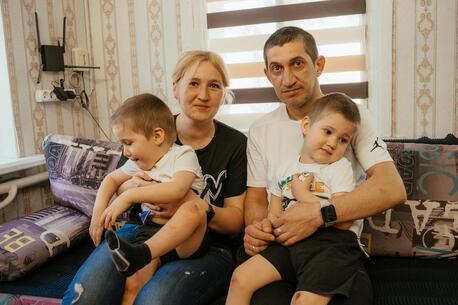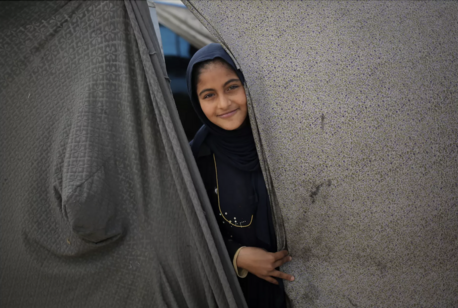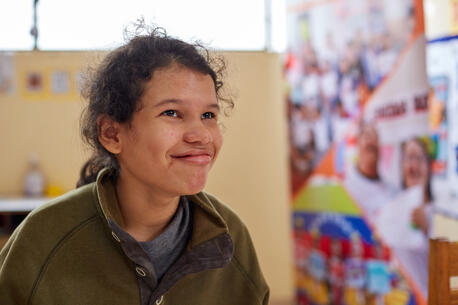
Inclusive Learning Opens Doors for Special Needs Students in Indonesia
In 1989, world leaders gathered to make a historic commitment to the world's children by adopting an international legal framework — the United Nations Convention on the Rights of the Child. The core idea expressed in the CRC is that childhood is a special, protected time, in which children must be allowed to grow, learn, play, develop and flourish with dignity.
Children with disabilities share the universal right to learn and live as active members of their community
The CRC was the first human rights treaty to include disability as a ground for protection from discrimination. It emphasized that children with disabilities have a right to a "full and decent life in conditions which ensure dignity, promote self-reliance and facilitate the child's active participation in the community."

There are approximately 93 million children with disabilities in the world, and even before the COVID-19 pandemic began, nearly 50 percent were not enrolled in school. UNICEF works around the world to ensure that children with special needs — one of the most marginalized and excluded groups in society — have the opportunity to learn and grow.
Even before the COVID-19 pandemic began, nearly half of the 93M children with disabilities were not in school
Inclusive education is a big part of that: UNICEF aims to foster a welcoming community where all students can learn side-by-side. Above, 12-year-old Syaiful (center, in orange) studies the Quran with classmates in a UNICEF-supported inclusive education program at Madrasah Ibtidaiyah in Banyumas, Central Java, Indonesia. A 2018 household survey found that close to 3 in 10 children with disabilities in Indonesia had never been to school.

The inclusion program at Madrasah Ibtidaiyah is a collaboration between the Government of Indonesia, UNICEF and Lembaga Pendidikan Maarif Nahdiatul Ulama, with support from Reach Out to Asia and the FC Barcelona Foundation. UNICEF and partners lead trainings and workshops designed to help teachers learn how to identify disabilities and learning barriers.
UNICEF works with partners around the world to train teachers on how to create a more inclusive learning environment for all children
Thirteen out of 14 teachers at Madrasah Ibtidaiyah have received guidance on how to modify lessons to make them more inclusive for students like Syaiful, who cannot freely move his lower body or his right hand, and to develop individual learning plans to support children who may need extra help. Above, Syaiful studies with his UNICEF-trained teacher, Fatikhatus, at his grandfather's home in Banyumas.

In addition to training key players within the education system and providing technical assistance to governments and partner organizations, UNICEF monitors the longterm effectiveness of inclusive education programs through consistent check-ins and evaluations. Above, 9-year-old Kevin, who has a visual impairment, works on a drawing at home in Banyumas. Kevin is also a student at Madrasah Ibtidaiyah.

UNICEF also advocates on behalf of underrepresented children to bring education for all, demanding change from policymakers and spreading awareness amongst the general public.
With the right support, children with disabilities thrive in an inclusion setting. Inclusive learning teaches children from a young age that their uniqueness and independent identities are valued, fostering growth and development within the classroom and beyond. Above, Kevin, 9, pushes his best friend, 12-year-old Syaiful, in his wheelchair as they play outside Syaiful's home in Banyumas, Central Java, Indonesia.
Top photo: Syaiful (left), 12, a child with a physical impairment, sits next to his best friend, Kevin, 9, a child with a visual impairment, in Banyumas, Central Java, Indonesia. The boys attend an inclusive education program at Madrasah Ibtidaiyah 1 Ciberem in Central Java, a collaboration between the Government of Indonesia, UNICEF and Lembaga Pendidikan Maarif Nahdiatul Ulama, with support from Reach Out to Asia and the FC Barcelona Foundation. All photos © Fauzan Ijazah for UNICEF
HOW TO HELP
There are many ways to make a difference
War, famine, poverty, natural disasters — threats to the world's children keep coming. But UNICEF won't stop working to keep children healthy and safe.
UNICEF works in over 190 countries and territories — more places than any other children's organization. UNICEF has the world's largest humanitarian warehouse and, when disaster strikes, can get supplies almost anywhere within 72 hours. Constantly innovating, always advocating for a better world for children, UNICEF works to ensure that every child can grow up healthy, educated, protected and respected.
Would you like to help give all children the opportunity to reach their full potential? There are many ways to get involved.





